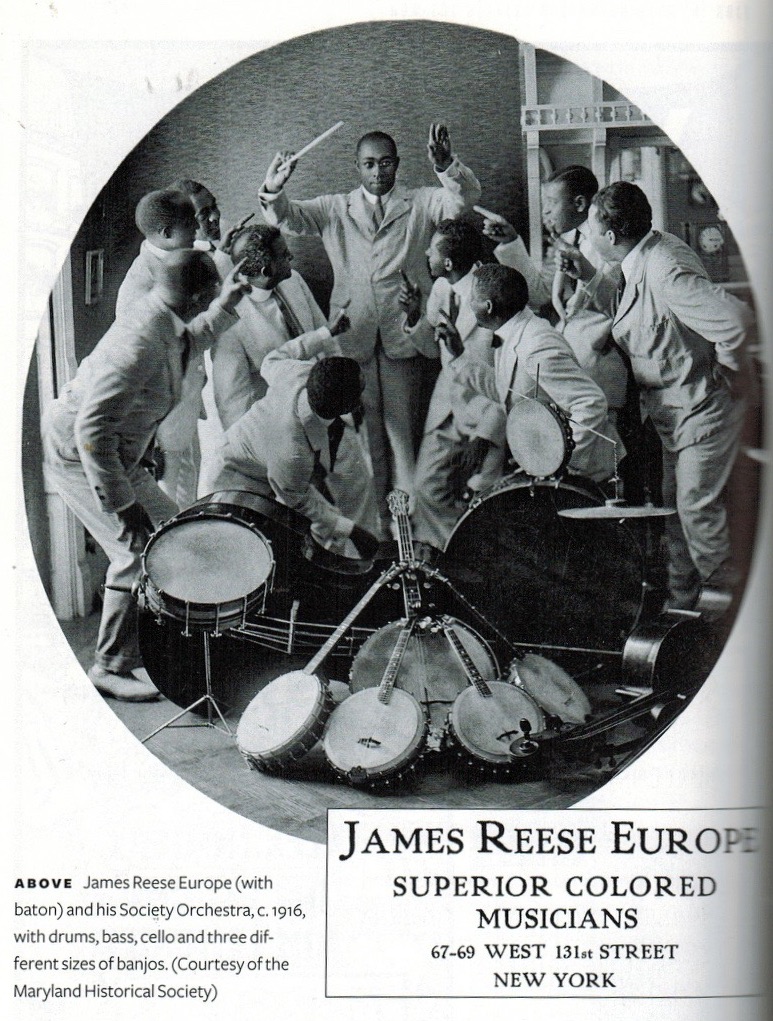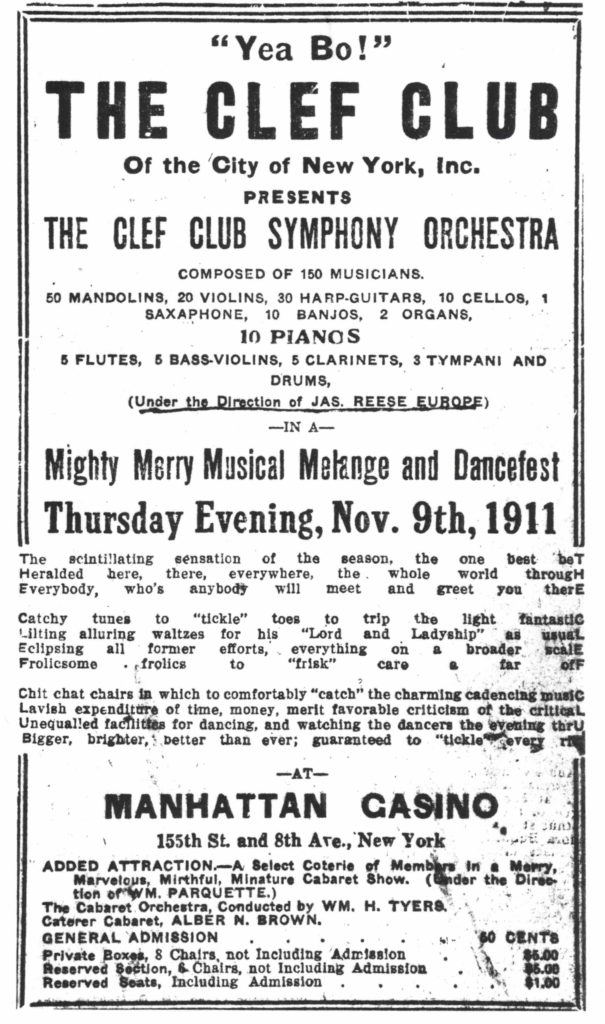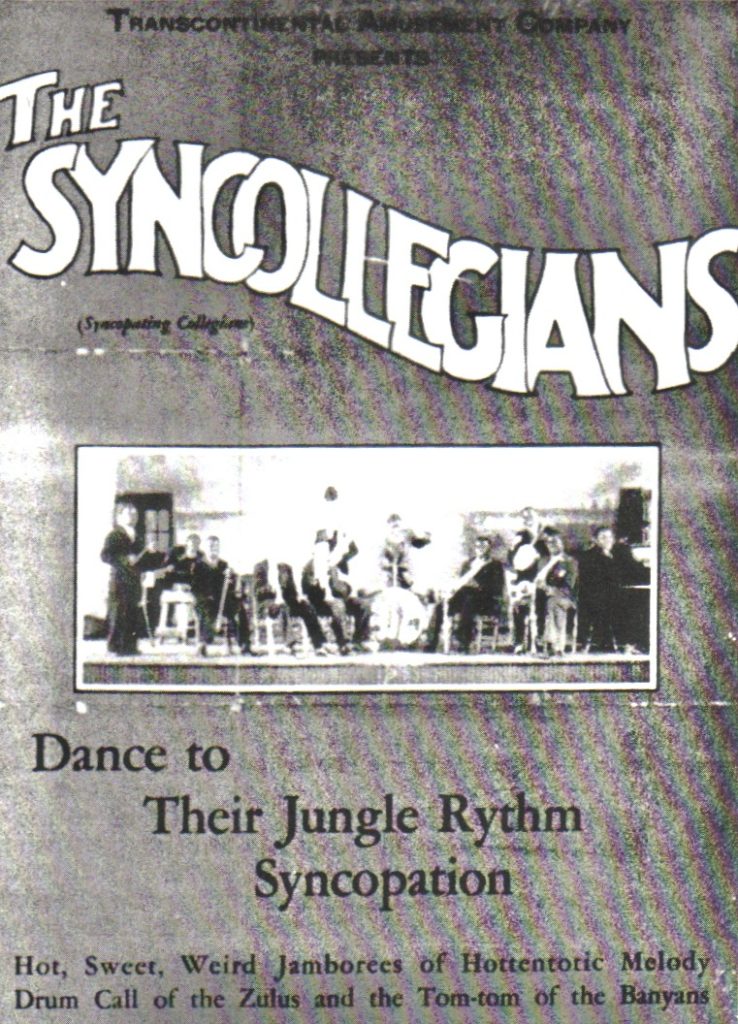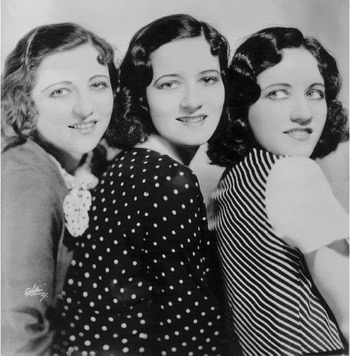In 1913, New Orleans’ Storyville district, where much jazz was heard and much illegality was shared, was temporarily closed by the city after two men were killed in a fight. Musicians began to emigrate north and east. Storyville reopened, but economic changes and war forced continued migration. In the 1920s, many New Orleans musicians drifted to Chicago, St. Louis, Kansas City, and later New York. In their encounters with jazz musicians already resident in those cities, the influences were mutual.
In Chicago, King Oliver and Louis Armstrong inspired a generation of White jazz players including Benny Goodman, Gene Krupa, and Jack Teagarden. Jazz was in ferment, growing up, growing complex and sophisticated—and somewhat more accepted. The maturing of jazz was apparently timely: it proceeded to transform the nature of mainstream popular music, reaching into its rhythms and forms, twisting and reordering them into a twentieth-century music of mixed influences from which there would be no going back.
In the second half of the nineteenth century, the various threads of American music had been gradually weaving together, and in the first two decades of the twentieth century they were finally being recognized at home and abroad as a distinctly American art. The interplay between African‑American and European folk and classical forms defined this new music.
The African‑American community, meanwhile, was in a dynamic state: expectations of progress were energizing Black organizations, which included the NAACP and the Garvey movement. This atmosphere also encouraged an artistic movement, exemplified by the Harlem Renaissance and Chicago’s “Fat Years.” African‑American writers and artists came into their own; so did—over the misgivings of some of the African‑American intelligentsia—jazz music and dance.
W.E.B. DuBois, for one, was not as enthusiastic about it as were Langston Hughes and Zora Neale Hurston. Among African-Americans there was a difference over cultural/social strategy; on the part of the White establishment, the resistance to jazz was a reaction to the upsurge in Black pride. Of a bumper crop of hysterical articles, perhaps the cleverest title was “Does Jazz Put the Sin in Syncopation?”; but the most telling may have been “Jazz is a signboard on the road that was traveled by Greece and Rome.” The New York Times, in its usual fine, if equivocating, style, ventured in an article “Jazz and Its Victims,” that jazz players
…seem to have made themselves the vanguard of the movement to do away with repression in America…while {the listener] is half conscious of the main melody, a subtle bombardment is carried on by all the other overtones, the curlicues, the rasps, the blares, the moans.[i]
A simpler view was voiced by a critic for the New York Post: “Jazz isn’t music. Not by a long shot.”

But plenty of people thought it was music, at least music enough to dance to. Vernon and Irene Castle, famous for teaching the foxtrot, had help with the dance’s development from Black bandleader James Reese Europe, at the instigation of W.C. Handy.[ii] “It was Jim Europe who suggested the fox-trot to us,” said Irene, “and [he] deserves all of the credit for the most popular dance of today.”[iii] Castle, along with Eileen Southern, was saying that Europe invented the foxtrot.[iv] His partnership with the Castles introduced syncopating orchestras and dance steps from the black community to the nation. Their work together was essential in inaugurating the jazz age, distinguished by two widespread enthusiasms: for African American popular music and for dancing.[v]
Alabama-born Jim Europe gave the first “syncopated concert” in New York in 1904, then brought the saxophone from Europe to New York around 1910. He also founded the most popular army band in Europe during World War I. The band led the New York parade after the armistice—the first parade to go up Fifth Avenue instead of down, so it could end up in Harlem, where the band’s original fan base was. This band brought Just-Before-Jazz, or Swingin’ Military, to Europe and to the armed forces. I hate to say anything nice about war or conquest, but as Europe said of his Champs-Elysées concert:
Before we had played two numbers the audience went wild. We had conquered Paris. General Bliss and French high officers who had heard us insisted that we should stay in Paris, and there we stayed for eight weeks…We played to 50,000 people at least, and, had we wished it, we might be playing yet.”[vi]
Other African American army bands played the European theatre, led mostly by New York bandleaders. Tim Brymn’s outfit was called the Seventy Black Devils of the U.S. 350th. Such bands set the styles for the next musical era, and paved the way for Josephine Baker and all the African American chic in Europe since.

Seven year-old George Gershwin (Jacob Gershvin) sat on a Harlem curb for hours, listening to Jim Europe’s band.[vii] Some of Europe’s bands were actually orchestras; his Negro Symphony Orchestra incorporated up to ten pianos, eight banjoes and 47 mandolins. He took control of New York’s music scene by organizing the African American musicians of the city into the Clef Club and booking various sorts of bands all over town, all in the service of his vision: to transmit the essence of African American harmony and rhythm through dance music.
James Europe’s music perched on the cusp between ragtime and jazz. At a wartime concert in France,
The drummers hit their stride with shoulders shaking in syncopated time…The audience could stand it no longer, the “jazz germ” hit them and it seemed to find the vital spot loosening all muscles…[viii]

European bands examined Mr. Europe’s band instruments with furrowed brows, certain they had been modified to produce the jazz germ—“smears, slurs, rhythmic or dynamic shifts…”[ix] After the war, Europe took New York by storm, offering what the New York Sun called “a gorgeous racket of syncopation and jazzing;”[x] the presentation combined New Orleans jazz with a big band sound. He presented “A Concert of Negro Music” at Carnegie Hall in 1912 with a 125-piece orchestra. Jim Europe would have been one of the most important bandleaders of the twenties, had he not been stabbed to death in 1919. Eubie Blake later called him “the Martin Luther King of music.”
Other black bands in New York scoured the nation for innovation; in 1918 Will Marion Cook’s New York Syncopated Orchestra hired Sidney Bechet, a Creole fella straight outa Downtown New Orleans, by way of Chicago. A few years later top black bandleader Fletcher Henderson would woo Louis Armstrong from the Windy City, strengthening the national profile of New Orleans trendsetters.
With the advent of Prohibition, Harlem night spots like the Cotton Club and the Apollo Theater drew large and enthusiastic White audiences. Popular African‑American musicians like Cab Calloway, Fletcher Henderson, and Fats Waller were top of the pops.[1] What they played, as always, was affected by their all-White audiences. It became a smoother sound, less raw, less gutbucket: Fletcher Henderson put a gloss on Louis Armstrong; Ethel Waters polished Bessie Smith’s style. Waters’ polish got a rave from Harlem Renaissance patron Carl Van Vechten, who patronized:
In her singing she exercises…subtle skill. Some of her songs she croons; she never shouts. Her methods are precisely opposed to those of the crude coon shouter, to those of the authentic Blues singer, and yet, not for once, does she lose the veridical negro atmosphere. Her voice and her gestures are essentially Negro, but they have been thought out and restrained, not prettified, but stylized.[xi]
[1] He could do more than pops, Waller could.
He once sat down at a party and played the entire score
to the ballet Petrushko. While drunk. (Hammond, 50.)
These were all great musicians who made fantastic music that we all love dearly, but do let’s observe that the sweetening was necessary for the task of the day. Likewise, the widespread use of an “octoroon”[2] chorus line—what Zora Neale Hurston called “the bleached chorus”—was clearly developed to accommodate White tastes.
[2] A person alleged to have one-eighth African ancestry.
________________________________________
CHICAGO BOYS
The impetus for new artistic styles in society often comes from the disenfranchised groups.[1] This doesn’t mean somebody else can’t join in. On the contrary, anyone who is born to respectable society but somehow doesn’t fit in, doesn’t find meaning in it, must search elsewhere. The search for meaning is, after all, the central quest of life (after food, clothing, and smart phones), and those who must struggle as a community to survive are bound to create an art that speaks to the soul and gives meaning to it.
[1] Look to the literature on Roman use of Greek styles
(alluded to above by a jazz-age magazine writer),
the classic case of the “conquered conquering the conqueror.”
So it was with Chicago jazzman Bix Beiderbecke, born in Iowa in 1903. He took to jazz and it took him in. His cornet playing was widely acclaimed – critic Phil Elwood credited his hot solos with the Paul Whiteman orchestra with selling a lot of records for that otherwise rather square ensemble. Bix played in a somewhat European style, directly on the notes, unlike the slurring style of Louis Armstrong. In fact, his original inspiration was the Dixieland Jazz Band of Nick LaRocca. He later soaked up Black bands on Chicago’s South Side, but he had little or no involvement with the blues, and on recordings he backed up singers like Bing Crosby.[xxi]
All the White Chicago jazz cats frequented Black clubs, to the bemusement of the doormen, who would remark “You came for another music lesson, didn’t you?”[xxii] Doormen and others were well aware of what would happen if a Black musician went to a White club to study. But Mezzrow, Beiderbecke, Eddie Condon et al were able to study King Oliver and Satchmo, Jimmy Noone and Earl Hines, up close, carrying on the American musical apprenticeship tradition.
The White Chicago players were later compared to the famed “Second Line” of people who danced along in the march behind New Orleans jazz bands.[xxiii] Perhaps rock and roll is rhythm and blues’ second line. The problem with these second-liners from the Black musician’s perspective was that, given the isolation of the South Side from any other side, it was easy for White visitors to take back souvenirs of their travels and present them without attribution. Blacks are not unaware of White library patrons’ borrowing habits. So Joe Oliver used to be quite cagey with information about his tunes, even their titles, when visitors inquired[xxiv].
Still and all, Bix and the boys were a key link in the expansion of jazz throughout the country and beyond its Black origins much as, forty years later, white Chicago boys Mike Bloomfield and Paul Butterfield would plunge into the world of the blues and bring them to White youth. Bix must have had the blues, to drink himself to death at 28.[2]
[2] Among Bix’s friends were violinist Joe Venuti and Indiana’s Hoagy Carmichael,
who wrote the music for “Stardust,” “Georgia on My Mind,” and “Up A Lazy River.” He was a songwriting giant, and recorded with Beiderbecke.
________________________________________
Art Hickman and Ferde Grofé were developing the call-and-response section sound—strings here, horns there, reeds up yonder, etc.—in their pre-jazz San Francisco bands around the time Jim Europe was in Europe. Jean Goldkette, a French immigrant working in New York, hired Beiderbecke, the Dorseys, Eddie Lang and Joe Venuti for a band that played hot, interesting arrangements. He also hired Don Redman of the Fletcher Henderson band to rehearse his groups.[xii] He went on to manage the Casa Loma Band, which was sweeter and played widely on the college circuit.
One of the most influential bands of any color was that led by Paul Whiteman (which he was). Not just a musician, he was a businessman to beat the band, owning or controlling 28 bands at once and making a million 1920s-style dollars a year. His activities were summed up at the time by writer and anthropologist Zora Neale Hurston:
Paul Whiteman is giving an imitation of a Negro orchestra making use of white-invented instruments in a Negro way. [xiii]
Whiteman’s sole arranger for five years was Ferde Grofé. After this he was also making use of Black arrangers, such as Don Redman, who also arranged for Fletcher Henderson’s band and later (like Henderson) for Benny Goodman. Redman was a pioneer in developing the call and response sections for swing band arrangements, getting ideas from Bill Challis, who had arranged for Jean Goldkette and picked up some concepts from Grofé and others from Bix. Redman invented the “swing choir,” with musicians chanting a paraphrase of the lyrics under a melody solo. Tommy Dorsey copied this to good effect.[xiv]
Other crossover arrangers included Sy Oliver of Jimmy Lunceford’s band, working for Tommy Dorsey, and Andy Gibson writing for Charlie Barnet and Harry James. Black bands were not known for using White arrangers; there was little money and rare call for it. But White bands’ use of Black arrangers was standard practice in the twenties. Redman was paid $100 each for twenty arrangements.[xv] Compare that to what Whiteman, the “King of Jazz,” made from Redman’s work and you’ll have a gut feeling for Karl Marx’s concept of “surplus value”: the worker provides the value and the king reaps the surplus.
There were exceptions: Bill Challis also arranged for Henderson, whose famous saxophonist and arranger Benny Carter called Challis his idol. Other White Henderson band arrangers included Will Hudson and trombonist Russ Morgan.[xvi] Henderson’s was the top band in the New York scene, and this was a time of great interplay between jazz and the traditions of orchestras, a time of swiftly evolving arrangements. The interaction across the color line seen here would be repeated in soul music in the sixties.
To his credit, Whiteman was one of the earliest to promote jazz from the bully pulpit, paying for new music by Gershwin and Black composer William Grant Still[3] and employing singer Mildred Bailey as well as Bing Crosby (before industry figures importuned Crosby to cut out all that jazz). He helped lay the groundwork for the big band fashion fifteen years ahead of the swing era. He was an important popularizer and synthesizer (acoustically) of modern popular music. Odd, then, that he cautioned his musicians against syncopation, saying that “to-day it is no longer a necessary thing,” and made heroic attempts to modernize, sanitize, stylize, formalize, and de-Africanize the music. [xvii]
[3] Still is known primarily for classical composition,
but he also composed jazz, wrote arrangements for W.C. Handy,
and played in the Harlem Symphony along with
Fletcher Henderson and James P. Johnson.
________________________________________
THE BOSWELL SISTERS
A seismic event in vocal style, this jazzy White sister act emerged in New Orleans in the late twenties. They excelled at vocal imitations of instruments—already a jazz tradition—and revolutionized group harmony. During the thirties they were the hit of the air waves, and recorded with the Dorsey Brothers, Les Paul, Carmen Miranda, Guy Lombardo, Bing Crosby, and, notably, the Mills Brothers, a Black quartet that broke new cultural and musical ground. The Boswells’ recordings included “Boogie Woogie Bugle Boy,” “That’s How Rhythm Was Born,” “Rock and Roll,” and plenty of Duke tunes.
Connee Boswell, the arranger (and one of the first women to be respected as such in the industry), was confined by polio to a wheelchair from the age of three. Later, after her two sisters retired, she went on to a solo career and was one of the most influential White singers—no less than Ella Fitzgerald said “When I started out, all I wanted was to sing like Connee Boswell.” Her syncopated phrasing, diction, swing, and frequent changes of tempo were exciting and unusual, especially for a White singer of that era. Her main influence was fellow New Orleanian Louis Armstrong.[xviii] From him, or from Barbershop singing generally, the sisters incorporated vocal slides and similar techniques. And before encountering Satch, the sisters used to visit a local Black theater that admitted Whites on Fridays, where they were wowed by Mamie Smith.[xix]
And before that, they learned something about Black music from their African American servants. Downbeat noted in 1944 that
the Boswell household had “colored women” in the household who “jived,” “crooned,” and “rocked”; and because of this, “No wonder [they] … sang the way they did! It was only natural for them to sing blues on the pop tunes, and spirituals on the blues.”[xx]

At this early stage of the recording industry, non-southerners were not familiar with southern accents or singing styles except for a few scattered Black performers, along with the caricatures purveyed by minstrelsy. The Boswells, eschewing exaggerations and offering their natural accents combined with jazzy vocal chops, were perceived by many as a Black act, as was Elvis 25 years later. In fact, when they were scheduled into Paris and no promo photos had been provided, a French artist drew them as Black. After all, light-skinned Black singers in vaudeville had frequently passed as White—including sister acts. And the New Orleans music world was a rainbow of color mixes, thanks in part to the plethora of “Creoles of Color” in the jazz scene there.
Though the White record-buying public had just recently been (more or less) weaned off of minstrelsy, they still needed to sort out their relation to Black musicians (and people, of course), and the appearance of the Boswells on the scene was an opportunity to begin a transition in that fraught relation. But it had to be carefully constructed in order to sell—thus the emphasis on their Southernness, and Southern Whiteness as well. Jack Kapp, the charge d’affaires at Brunswick Records, took charge:
In the Boswells, Kapp had found his marketing Holy Grail. They were white singers that sang white material (i.e., Tin Pan Alley rather than blues) but sounded black, who could ride the crest of the popularity of black music while simultaneously drawing in more racially conservative white audiences. [xxi]
We’ll encounter this again with Elvis and his own Kapp, Sam Phillips—and, less famously, throughout the history of the industry. And we’ll see other Whites adopting Black styles whole cloth, including the second version of the Chicago Boys (Butterfield, Bloomfield, et al), who took up the blues in the sixties.
But this time, the mix of Southernness with the female (Southern Belle[1]) aspect maneuvered White audiences forward. The contemporary listener might ambivalate, “Yes, they sound Black, but that’s ok, because they’re Southern.” They were presenting the South, including its Blackness, to the North, rather than presenting themselves as renegade Whites adopting Black culture.
[1] One can, however, make the case that the Belle persona,
or stereotype, inevitably carries with it the plantation culture itself—
reduced in potency, but still a vessel for (hidden) white supremacy.
And in that era, the rise of Black performers alternately enthralled and threatened the White cultural consumer. Laurie Stras, in White Face, Black Voice: Race, Gender, and Region In the Music of the Boswell Sisters, speculates that the deployment of Louis Armstrong’s signature styles—vocalized “instrumental” solos, scat, etc.—by the Boswells helped to make Satchmo more acceptable by spreading his musical manners across the color line and recasting them as not only Black but as Southern: inescapable fingerprints of the evolving music of the era. As Southern Belles, they were nearly above conservative reproach, even as they served up a stew of African American jazz-pop. Not everyone appreciated it, though: a complaint to a San Francisco radio station demanded:
Please, please, if you are going to keep those Boswell Sisters tell them to change their stuff and quit that squawking and harmonize a tune. All my friends say the same thing. They call them the savage chanters and tune them out.”[xxii]
But the die was cast: popular music, and the people that made it popular, were moving forward with a new amalgam of styles taken, once again, from the Black community. Together with their friend Bing Crosby, the Boswells stepped into a new era—not always without resistance from audiences and industry commissars alike, but step they did, and certainly it was a step above minstrelsy.
__________________
[i] “Jazz and Its Victims,” New York Times, October 7, 1928
[ii] Badger, 52.
[iii] Locke 1936, 67.
[iv] Ibid. and Southern, 1971, 350.
[v] Charters and Kunstad, 31-34.
[vi] Southern, 1971, 364.
[vii] Ewen, 228.
[viii] Badger, 56
[ix] ibid., 58
[x] loc. cit.
[xi] cited in Kellner.
[xii] Clarke, 167.
[xiii] Zora Neale Hurston, quoted in Hemenway 1977, 80-81.
[xiv] Clarke, 169.
[xv] Buerkle, 106.
[xvi] Lees, 201.
[xvii] Ogren, 1989, 160.
[xviii] Friedwald, Will, Jazz Singing, New York:Collier/MacMillan, 78.
[xix] Placksin, 23.
[[xx] John Lucas, “Cats Hepped by Connee’s Chirping,” Down Beat, 15 October 1944, 3
[xxi] Laurie Stras, White Face, Black Voice: Race, Gender, and Region In the Music of the Boswell Sisters, Cambridge University Press, May 16, 2007, accessed May 13, 2023 at bit.ly/strasboswells
[xxii] David McCain, liner notes to The Boswell Sisters Collection, Volume 5, Nostalgia Arts NOCD 3023, 2001
